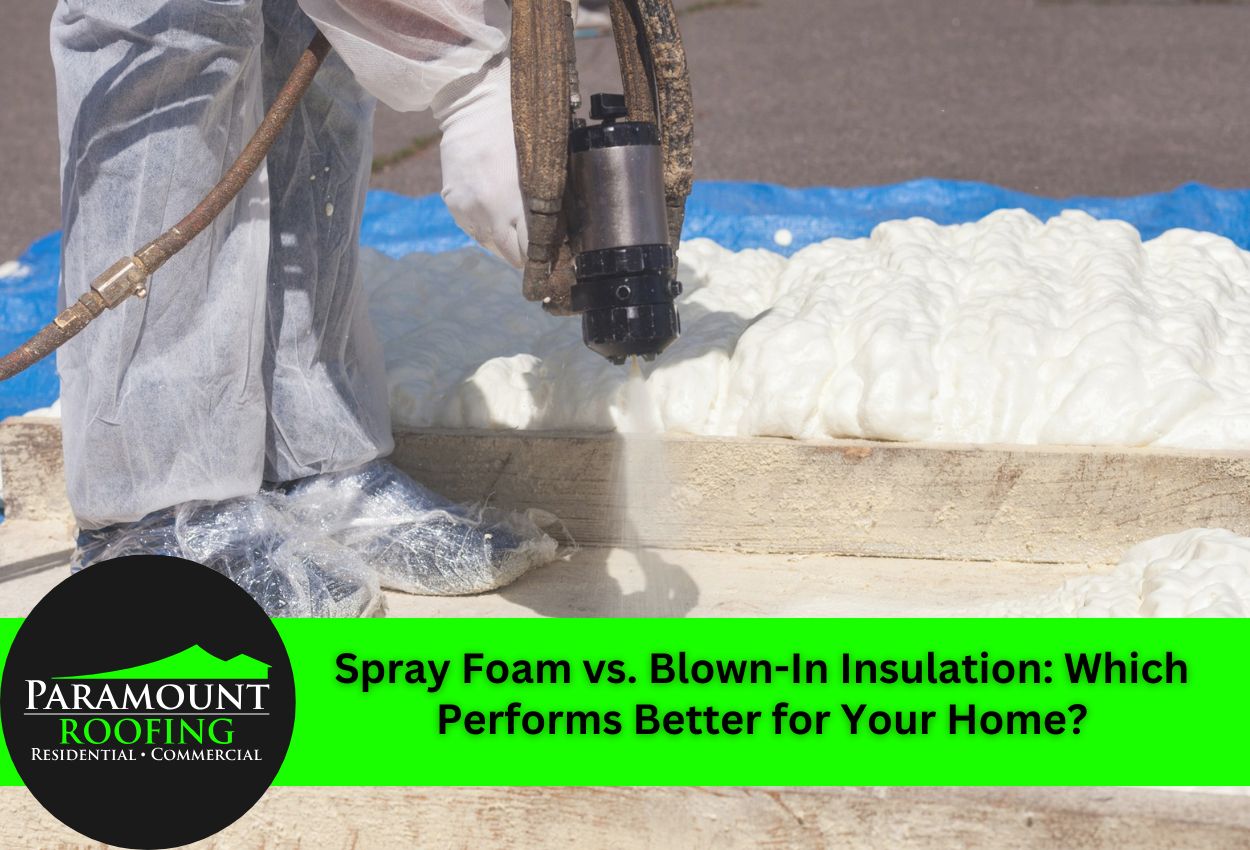Detroit homeowners face unique insulation challenges with freezing winters and humid summers that put heating and cooling systems to the test. Having the right insulation isn’t just about your comfort; it’s essential for managing energy costs in Michigan’s extreme climate. When evaluating insulation options, spray foam and blown-in insulation represent two popular, but distinct, approaches that can significantly impact your home’s efficiency and comfort.
Spray foam insulation creates an airtight seal by expanding within the space that it’s sprayed, adhering to surfaces, and filling gaps that might otherwise allow air leaks. This modern solution has gained popularity for its superior insulating properties and moisture-resistant characteristics. Blown-in insulation, on the other hand, consists of loose materials mechanically blown into the attic space and wall cavities, creating a thermal barrier that slows heat transfer between your home and the outside environment.
The choice between these types of insulation not only affects your immediate comfort but also the long-term energy consumption, potential moisture issues, and roof performance. For Detroit residents, where temperature swings can be dramatic and precipitation substantial, selecting the right attic and roof insulation materials becomes particularly important. Understanding the performance differences, installation requirements, and energy-efficient benefits of each option provides the foundation for making an informed decision that aligns with your home’s specific needs.
What Sets These Insulation Options Apart?
Spray foam and blown-in insulation differ significantly in composition and application methods, each offering unique benefits for Detroit homes. Spray foam insulation consists of liquid polyurethane that expands on contact, creating a solid barrier. Open-cell spray foam expands to 100 times its original volume, offering sound-dampening properties, but a lower R-value. Closed-cell foam, denser and more moisture-resistant, provides superior insulation with R-values of 6 or 7 per inch, which is ideal for Michigan’s harsh winters.
Blown-in insulation comes in cellulose (made from recycled paper treated with fire retardants) and fiberglass varieties. These loose-fill materials are mechanically installed using specialized blowing equipment that propels the insulation through hoses into attic spaces and wall cavities.
The installation process for spray foam involves applying liquid chemicals that react and expand, adhering directly to surfaces and creating a seamless barrier that conforms to irregular spaces. Meanwhile, blown-in materials settle into place to fill cavities without adhesion, relying on volume and density for effectiveness.
For Detroit homeowners, understanding these fundamental differences is crucial. Spray foam creates an air-sealed envelope that can enhance the roof’s structural integrity, while blown-in options offer excellent thermal resistance with minimal disruption to existing structures. Both can significantly reduce energy costs in Michigan’s extreme temperatures.
R-Value and Performance: Insulation Effectiveness in Michigan’s Climate
R-value measures thermal resistance, which is how effectively insulation options block heat transfer, and becomes critically important in Detroit’s extreme temperature swings. Closed-cell spray foam boasts the highest R-value at 6 to 6.5 per inch, while open-cell spray foam provides R3.5 to R3.7 per inch. Blown-in cellulose typically delivers R3.2 to R3.8 per inch, with fiberglass slightly lower at R2.2 to R4.3 per inch. In practical terms, this means spray foam requires less material thickness to achieve the same insulation value as blown-in alternatives.
Beyond raw R-value, real-world performance in Michigan homes depends on how insulation handles air movement and moisture. Spray foam creates an airtight seal that virtually eliminates air infiltration, which is a significant advantage during Detroit winters when cold air seeks out every possible entry point. Blown-in insulation, while thermally efficient, cannot match spray foam’s air-sealing capabilities without additional air barriers.
Moisture management becomes particularly important during Michigan’s freeze-thaw cycles. Closed-cell spray foam serves as a vapor barrier, preventing moisture migration that can lead to ice dams on roofs. Blown-in insulation allows some vapor transmission, requiring proper attic ventilation to prevent condensation issues. Over time, spray foam maintains its performance while blown-in materials may settle, potentially reducing effectiveness in key areas of your attic and reducing protection for your roof structure.
Longevity and Durability: Which Insulation Stands the Test of Time?
When considering the long-term investment in your Detroit home, the durability of insulation becomes a critical factor. Spray foam insulation generally offers superior longevity, with manufacturers typically promising 20 to 30 years of performance without significant degradation. In reality, many roofing contractors report that spray foam often exceeds these estimates, sometimes lasting the lifetime of the structure when properly installed. This exceptional longevity stems from its rigid composition that resists settling, maintains its shape, and creates a moisture-resistant barrier.
Blown-in insulation presents a different level of durability. Cellulose materials typically maintain optimal performance for 15 to 20 years, while fiberglass may last 20 to 30 years. However, Michigan’s seasonal humidity can accelerate deterioration. The primary concern with blown insulation is settling, which can reduce effective coverage by 20% over time, creating cold spots in attics and diminishing protection for roofing structures. Additionally, blown materials absorb moisture more readily, potentially leading to compaction and decreased R-value during Detroit’s humid summers.
Pest resistance represents another aspect of durability you’ll need to consider. Spray foam’s solid structure provides an effective barrier against rodents and insects that commonly enter Michigan homes during colder months. Blown insulation, particularly cellulose, may require additional borate treatments to resist pests. For Detroit homeowners, spray foam’s superior resistance to moisture cycling, seasonal temperature fluctuations, and settling makes it particularly valuable for protecting roof systems and attic spaces against our region’s challenging climate conditions.
Installation Considerations for Detroit Homes
The installation process for spray foam and blown-in insulation varies significantly, affecting both timeline and feasibility for Detroit homeowners. Spray foam requires meticulous preparation, including clearing the installation area completely and ensuring surfaces are clean and dry. Professional installation is necessary due to specialized equipment and the chemical mixing process. The curing time typically ranges from 24 to 48 hours, during which proper ventilation is essential as the chemicals release volatile organic compounds (VOCs).
Blown-in insulation offers a more straightforward installation process. While DIY options exist, professional installation ensures the right density and coverage, particularly in Detroit’s older homes with irregular spaces. The installation is less disruptive, with minimal drying time and fewer preparation requirements, allowing homeowners to reoccupy spaces almost immediately.
The available homes in Detroit create unique challenges around retrofitting insulation. Many historic homes feature plaster walls, uneven framing, and complex roof structures. Spray foam excels in sealing irregular spaces inside these older homes, preventing drafts through stone foundations and addressing the thermal bridging common in early 20th-century construction. Blown-in insulation offers less disruption to existing structures, making it ideal for adding insulation to finished walls through small access holes.
For new construction, spray foam provides an opportunity to create a completely sealed building, while blown-in options integrate well with standard framing practices at potentially lower initial installation costs.
Environmental and Health Impacts: Making a Responsible Choice
When selecting insulation for your Detroit home, environmental and health considerations deserve careful attention. Spray foam insulation typically has a higher initial environmental footprint due to its petroleum-based ingredients and chemical processes. However, its superior energy efficiency often offsets this impact over time through reduced heating and cooling demands. Some manufacturers now offer spray foam formulas with recycled or bio-based content to address sustainability concerns. When it reaches the end of its lifespan, it can also be hard to remove since the foam adheres permanently to surfaces and isn’t easily recyclable.
Blown-in options generally start with a smaller environmental footprint. Cellulose insulation contains up to 85% recycled paper content, making it one of the most environmentally friendly choices available. Fiberglass typically contains 20% to 30% recycled glass. Both materials can be removed and potentially recycled at end-of-life, unlike spray foam.
Health considerations become particularly relevant in Michigan’s tightly sealed homes. Spray foam can emit VOCs during and shortly after installation, requiring temporary evacuation and proper ventilation. Once cured, quality spray foam is generally inert. Blown-in cellulose and fiberglass may contain dust particles during installation, though cellulose’s borate treatments help resist mold and pests without harsh chemicals. For Detroit homeowners with allergies or respiratory conditions, professional installation with proper protective equipment is essential for either insulation type.
Making Your Decision: Finding the Best Insulation for Your Specific Needs
Choosing between spray foam and blown-in insulation ultimately depends on the specific requirements of your Detroit homes. For budget-conscious homeowners, blown-in insulation typically offers lower initial costs while still providing significant energy-efficient improvements. This option works particularly well for straightforward attic insulation projects where air sealing isn’t the primary concern.
If you’re facing tight project timelines, it might be beneficial to use blown-in insulation, which has a quicker installation timeline and causes minimal disruption. On the other hand, if you’re planning for long-term energy efficiency in Michigan’s extreme climate, spray foam’s superior air-sealing properties and moisture resistance often justify the higher upfront investment, especially for protecting roofing structures against ice dams and weather-related stress.
Consider your home’s specific areas too. Spray foam excels in irregular spaces, rim joists, and crawl spaces where its expansion properties seal difficult-to-reach areas. Attics with complex ductwork or numerous penetrations benefit from spray foams’ ability to completely cover these potential leak points. Meanwhile, blown-in insulation works efficiently in open attic floors and enclosed wall cavities.
Many Detroit homeowners find a combination of using spray foam for targeted air sealing, followed by blown-in insulation for broader coverage, to be extremely effective. Qualified Detroit-area roofing contractors can provide valuable guidance on this hybrid strategy, evaluating the specific layout of your home, existing insulation, and energy efficiency goals to develop the best insulation plan for Michigan’s challenging climate conditions.
Choose the Right Insulation with Paramount Roofing
If you’re considering upgrading your home’s insulation, it’s crucial to choose the type that best fits your needs and budget. Spray foam insulation and blown-in insulation each have unique benefits, but deciding which is right for your Detroit home can be challenging. Paramount Roofing specializes in the precise installation of both types, ensuring optimal energy efficiency and comfort in Michigan’s extreme climate.
Understanding the specific advantages of spray foam’s air-sealing properties or blown-in insulation’s cost-effectiveness can significantly influence your decision. Don’t compromise on quality or performance. Let the experts at Paramount Roofing guide you to the best insulation solution for your home.
Ready to enhance your home’s comfort and reduce your energy bills? Call Paramount Roofing today at (586) 690-0227 to discuss your insulation needs and schedule a consultation.
 Free Estimate
Free Estimate
 Request Service
Request Service Locations
Locations 
